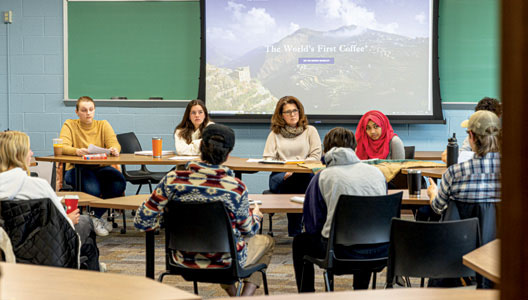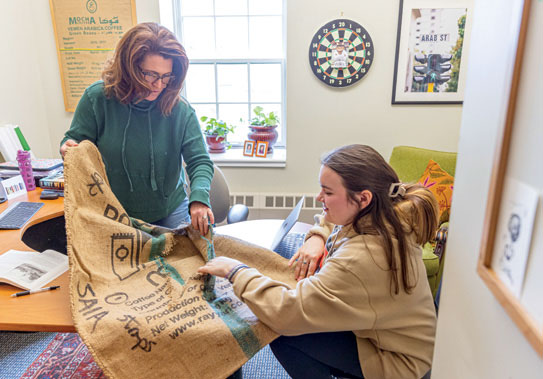The Pulteney StreetSurvey
In Global Studies 101, Professor of International Relations Stacey Philbrick Yadav and students examine the world through the lens of coffee. The introductory course, which changes themes and professors each semester, engages students in three key aspects of global studies: how things, people and words move around the world.
Finding the World in a Cup of Coffee
The newly organized Institute for Global Studies reimagines the relationships among internationally facing academic departments to encourage nuanced engagement across disciplines and with the wider world.
BY ANDREW WICKENDEN '09
The world drinks about two billion per day. For centuries, it’s been a social stimulant, late-night fuel and the best part of waking up, but coffee is also at the center of a global web of commercial, political and cultural history. Demand for coffee played an outsized role in colonial exploitation in South America, fueling the slave trade as well as environmental degradation that persists today. Coffee has underpinned artistic movements and societal upheaval in Europe, prompted regulatory reforms in the United States, and inspired debates over free- and fair-trade from Ethiopia to Indonesia.
The world drinks about two billion per day. For centuries, it’s been a social stimulant, late-night fuel and the best part of waking up, but coffee is also at the center of a global web of commercial, political and cultural history. Demand for coffee played an outsized role in colonial exploitation in South America, fueling the slave trade as well as environmental degradation that persists today. Coffee has underpinned artistic movements and societal upheaval in Europe, prompted regulatory reforms in the United States, and inspired debates over free- and fair-trade from Ethiopia to Indonesia.
Global Studies 101 is a new starting point for students interested in the fields of international relations, anthropology, or any of the Colleges’ area studies and language programs — nine majors in all — which have been brought under the academic umbrella of the Institute for Global Studies (GLS).
The new curricular initiative conceives of global studies as a unified enterprise with many points of entry and interconnected areas of specialization. Each program and department retains its academic integrity, but with a shared intellectual framework and resources, the GLS can leverage collaborations across disciplines, says Professor of International Relations Kevin Dunn. “We don’t want to lose the rich history of existing programs; we want to integrate them,” he explains, because “exposing students to a lot of different faculty voices and sets of expertise in a clear, structured way will open up a lot of doors and opportunities.”
The 101 course, which counts toward all majors within the GLS, is taught by a rotating roster of faculty members whose expertise shapes the course’s theme each semester, while regular guest lecturers offer additional context and perspectives on “global thinking.” Philbrick Yadav’s coffee course heard from Professor of History Colby Ristow, examining coffee and land conflict in Latin America; Associate Professor of Economics Keoka Grayson, comparing fair-trade and free-trade coffee production in East Africa; and Professor of Asian Studies James-Henry Holland, unpacking what it means to drink coffee in a tea-dominant society like Japan. Through such intentional interdisciplinary efforts, the GLS introduces students “to other faculty who are part of the same enterprise and showcase[s] the way interdisciplinary tools and principles are useful in a lot of different trajectories,” Philbrick Yadav says.
During the summer of 2022, with support from the Katherine D. Elliott ’66, L.H.D. ’08, Faculty Innovation Fund, faculty members developed a structure and set of concepts for GLS 101. Along with Philbrick Yadav and Dunn, Professor of Russian Area Studies Kristen Welsh, Visiting Associate Professor of Africana Studies James McCorkle ’76, P’20 and Associate Professor of French and Francophone Studies Court Wells each built a syllabus around a different topic to engage students in three key aspects of global connectivity: how things, people and words move across the world — and why.
In “GLS 101: Saltwater Crossings” this spring, McCorkle and his students examined the historical contexts and long-term implications of both chosen and involuntary journeys across seas and oceans. Next academic year, three sections of the 101 course will be offered, focusing, respectively, on crossing borders, global language and water. Regardless of the topic, the intro courses are intended to develop a shared base of knowledge, tools and perspectives for navigating global issues as students hone their skills in research, writing and interdisciplinary critical thinking.

Aiden Greiff ’25, an International Relations and Asian Studies double-major, says that this approach allows students to explore the world from historical, political, anthropological and economic perpsectives. “The transfer of ideas and people and finances and culture and technology — all of those can be really important in understanding why the world is the way it is and the current risks in our world of turmoil,” he says.
For Lamia Nur Rahman ’26, who is planning to major in Economics, Philbrick Yadav’s course put the “scale of impact that coffee has had on people of different communities… into perspective” and helped her “realize how connected the world is through commodities.”
Indeed, coffee’s historical evolution from good to commodity to industry takes students from Ethiopia through the Middle East and into Istanbul, where coffeehouses became a hub for social, political and artistic life in the 16th century. As coffee moved around the world, so did its impacts as a cultural, economic and environmental force. In revolutionary America, drinking coffee was an act of protest. During the Dutch colonial period in Indonesia, coffee was a key cash crop that staved off bankruptcy for the Netherlands and in the process inflicted famine and disease on Indonesians. After leaf rust devastated arabica coffee plantations in Asia, the robusta variety came to dominate Brazilian farms and American markets in the early 20th century. Robusta, which is more resistant to the fungus that causes leaf rust, doesn’t require the cool, shady, hilly conditions favored by arabica, so Brazilian growers, aided by advances of the second industrial revolution, could plant on a massive scale; this “quantity over quality” approach came at the expense of the environment and continues to stress already vulnerable habitats.
Welsh, who serves as associate director of the GLS, says the overarching intent of this new curricular endeavor is to illuminate this kind of global-historical interconnectedness — “that things don’t happen in isolation.” With its inherently liberal arts outlook, the GLS bolsters “the global engagement that is clearly so important to us as an institution,” says Welsh. Not only will this mindful curricular integration help “prepare students to get much more out of a semester abroad,” it will provide “a robust academic landing place for those students,” with opportunities to integrate experiences abroad into coursework, research and creative projects when they return to campus.
In turn, students develop skills in communication and critical thinking that are “helpful in creating a bridge between not only different departments but different cultures,” says Wells, director of the GLS. He conceives of global studies as a mindset as much it is an academic discipline, a way of approaching “a more and more interconnected world with a sense of humility and preparedness to go outside of yourself and understand someone else’s perspective.”
In other words, being an engaged global citizen starts with being an engaged global student.
